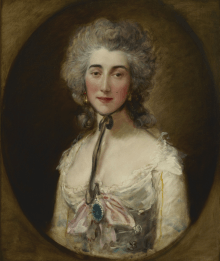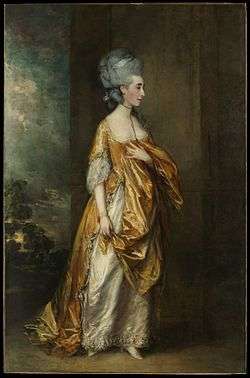Grace Elliott
| Grace Elliott | |
|---|---|
 Portrait of Grace Elliot by Thomas Gainsborough, circa 1778 (in the Frick Collection) | |
| Born |
Grace Dalrymple c. 1754 Edinburgh, Scotland |
| Died |
16 May 1823 (aged 68–69) Ville d'Avray, France |
| Burial place | Père Lachaise Cemetery, Paris |
| Nationality | Scottish |
| Occupation | writer, courtesan, spy |
| Known for | mistress of the Louis Philip II, Duke of Orléans |
| Notable work | Journal of my life during the French Revolution |
| Spouse(s) | Sir John Eliot (divorced) |
| Children | Georgina Seymour |
| Parent(s) |
Grisel Craw (mother) Hew Dalrymple (father) |
Grace Dalrymple Elliott (c. 1754–16 May 1823) was a Scottish courtesan, writer and spy who resided in Paris at the time of the French Revolution. Elliott was an eyewitness to events which she detailed in her memoirs, Journal of my life during the French Revolution (Ma vie sous La Révolution) published posthumously in 1859.[1][2] She was the mistress of the Duke of Orléans, and the future George IV, by whom she is said to have borne an illegitimate daughter. Elliott trafficked correspondence and hid French aristocrats escaping from the French Revolution. She was arrested several times but managed to avoid the guillotine, and was released after the death of Robespierre.
Early life
Elliott was born probably in Edinburgh about 1754, the youngest daughter of Grisel Craw (d. c.1765) and Hew Dalrymple (d.1774), an Edinburgh advocate concerned in the great Douglas case. Her parents separated around the time of her birth, and she was most likely brought up at her grandparents house.[3]
She was educated in a French convent, and on her return to Scotland, was introduced by her father into Edinburgh society. Her beauty made such an impression on John Elliott, a prominent and wealthy physician, that he made her an offer of marriage in 1771. She accepted, although Elliott was some 20 years her senior. They were married on 19 October 1771 in London. The couple entered fashionable society, but eventually grew apart due to their difference in age and interests.[2] In 1774 Elliott met and fell in love with Lord Valentia, with whom she entered into an affair. Convinced of his wife's infidelity, John Elliott had the couple followed and eventually sued Valentia for criminal conversation (adultery). He received £12,000 in damages before successfully obtaining a divorce.
With her social reputation destroyed, Elliott became recognised as a member of the demimonde and forced to earn her living as a professional mistress or courtesan. She was then taken by her brother to a French convent, but she seems to have been brought back almost immediately by Lord Cholmondeley, who became her lover and remained one of her principal protectors throughout her life.
Life in England
Having met Lord Cholmondeley at the Pantheon in 1776, she began a liaison with him that lasted for three years. Thomas Gainsborough painted a portrait of her in 1778, which is in the Frick Collection at the Metropolitan Museum of Art. In 1782, she had a short, concealed intrigue with the Prince of Wales (afterwards George IV) and gave birth to a daughter on 30 March 1782, who was baptised at St Marylebone as Georgiana Augusta Frederica Seymour (d. 1813) but used the name Georgina Seymour.
Elliott declared that the Prince was the father of her child and The Morning Post stated in January 1782 that he admitted responsibility. However, the child was dark in complexion, and when she was first shown to the Prince, he is said to have remarked, "To convince me that this is my girl they must first prove that black is white."
The Prince and many others regarded Lord Cholmondeley as the father of the girl, although the Prince's friends said that Charles William Wyndham (brother of Lord Egremont), whom she was thought to resemble, claimed paternity. Yet others thought she might have been fathered by George Selwyn. Lord Cholmondeley brought up the girl, and after her early death in 1813, looked after her only child.
Life in France. French Revolution

George, Prince of Wales, introduced her to the French Duke of Orleans in 1784 and by 1786, she had permanently set up residence in Paris and become one of Orleans' recognised mistresses. In exchange for her companionship, the Duke granted her a home on the Rue Miromesnil and a property in Meudon, to the south of Paris. During this period Elliott also pursued liaisons with the Duke de Fitz-James and the Prince of Conde.[5]
Much of what is known about Elliot's life in France is recorded in her memoirs, Journal of my life during the French Revolution. Although there are a number of inconsistencies in her account, her work has become one of the best-known English-language accounts of The Terror, documenting the movements of the Duke of Orleans and those within his aristocratic Jacobin circle at the Palais-Royal. During her life in Paris, Elliott witnessed the horror of the September Massacres and the body of the Princess de Lamballe carried through the streets. Although Elliott was an associate of the Duke of Orleans (who later took the name Philippe Égalité) her royalist sympathies soon became widely known throughout her district, and her home was frequently searched during the programme of domiciliary visits. It has been recently shown that Elliott was trafficking correspondence on behalf of the British government and assisting in the transportation of messages between Paris and members of the exiled French court in Coblenz and in Belgium.[1][2]
On several occasions, Elliott risked her life to assist and hide aristocrats who were being pursued by the Revolutionary government. Shortly after the Assault on the Tuileries Palace, on 10 August 1792, Elliott hid the injured Marquis de Champcentz by physically carrying him to her house on the Rue Miromesnil, at great risk. During a search of her home, she placed him between the mattresses of her bed and feigned illness. On another occasion, Elliott agreed to take in and hide Madame de Perigord and her two children at her home in Meudon, who were attempting to flee to England. Elliott was instrumental in arranging false travel documents for those wishing to escape the Revolution and after hiding Champcentz in the attic of her home in Meudon, she was able to orchestrate his passage out of France. In the spring of 1793 Elliott was arrested and imprisoned and spent the rest of the Terror incarcerated at several prisons, including the Recollets and the Carmes, where she claims to have met Joséphine de Beauharnais, though this assertion has been questioned by historians. Elliott details her harrowing experiences in prison, the violent coercion she experienced, as well as the illness and deprivation endured by her fellow prisoners.
Later life
Although many of her friends met their deaths, including Madame du Barry, Elliott did not. She narrowly avoided death and was released after the Reign of Terror came to an end, not before she had been confined in total to four different prisons by the republican government. In later years, there were rumours that she had an attachment with Napoleon Bonaparte, but had rejected his offer of marriage. She died a wealthy woman at Ville d'Avray, in present-day Hauts-de-Seine, in May 1823, while a lodger with the commune's mayor.[6]
She was buried in Père Lachaise Cemetery.[7]
Works
- Elliott, Grace Dalrymple (2011) [1859], During the Reign of Terror: Journal of my Life during the French Revolution, ISBN 9781230200811
Depictions in film and literature
A dramatic portrayal of part of her life is contained in the 2001 film The Lady and the Duke. English actress Lucy Russell played Elliott and Jean-Claude Dreyfus played the Duke of Orleans.
Grace Elliott also appears as a major character in Hallie Rubenhold's novel The French Lesson (Doubleday, 2016).
References
- 1 2 (Manning 2005)
- 1 2 3 (Major & Murden 2016)
- ↑ "Elliott [Eliot; née Dalrymple], Grace [nicknamed Dally the Tall] (1754?–1823), courtesan and writer", The Oxford Dictionary of National Biography, Oxford University Press, doi:10.1093/ref:odnb/8675, retrieved 2018-06-23
- ↑ "Mrs Grace Dalrymple Elliott". Metropolitan Museum.
- ↑ Elizabeth Sarah Villa-Real Gooch, Mrs (1792), The life of Mrs. Gooch, London, The authoress, OCLC 5398468
- ↑ (Manning 2005, pp. 349–351)
- ↑ (Manning 2005, p. 384)
- Attribution

Sources
- Major, Joanne; Murden, Sarah (2016), An infamous mistress : the life, loves and family of the celebrated Grace Dalrymple Elliott, Pen & Sword History, ISBN 1473844835
- Camp, Anthony J (2007), Royal mistresses and bastards : fact and fiction 1714-1936, A.J. Camp, ISBN 0950330825
- Manning, Jo (2005), My lady scandalous : the amazing life and outrageous times of Grace Dalrymple Elliott, royal courtesan, Simon & Schuster, ISBN 9780743262620
- Bleackley, Horace (1909), Ladies fair and frail; sketches of the demi-monde during the eighteenth century, London, J. Lane New York, J. Lane Co, OCLC 1523626
External links
- Grace Elliott's portrait by Thomas Gainsborough at the New York Metropolitan Museum of Art
- During the Reign of Terror: Journal of My Life During the French Revolution, fulltext of Grace Dalrymple Elliott's autobiography, 1910 edition]
- An Infamous Mistress: The Life, Loves and Family of the Celebrated Grace Dalrymple Elliott, Biography of Grace Dalrymple Elliott (2016) by Joanne Major and Sarah Murden